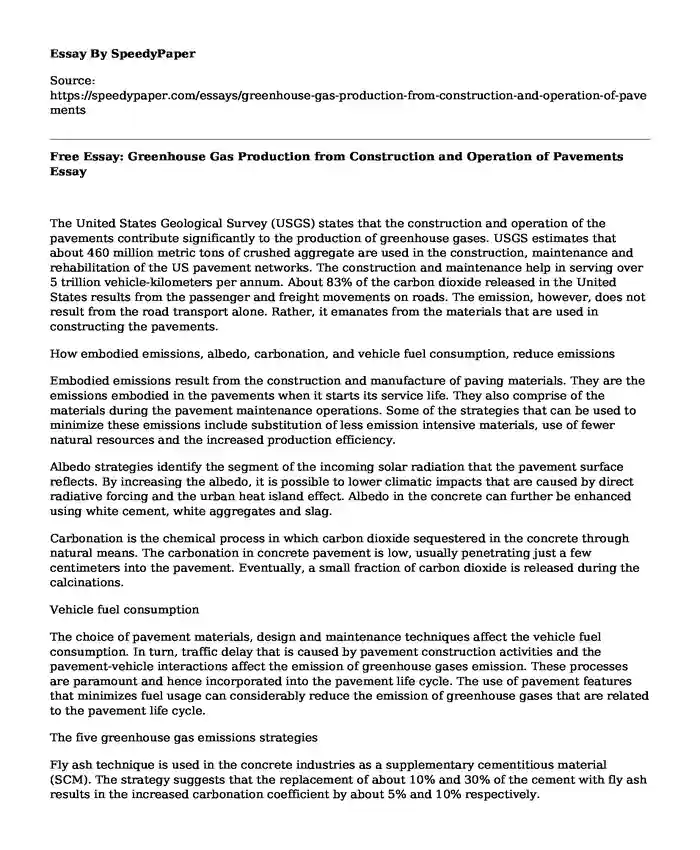
| Type of paper: | Essay |
| Categories: | Environment Air pollution |
| Pages: | 3 |
| Wordcount: | 665 words |
The United States Geological Survey (USGS) states that the construction and operation of the pavements contribute significantly to the production of greenhouse gases. USGS estimates that about 460 million metric tons of crushed aggregate are used in the construction, maintenance and rehabilitation of the US pavement networks. The construction and maintenance help in serving over 5 trillion vehicle-kilometers per annum. About 83% of the carbon dioxide released in the United States results from the passenger and freight movements on roads. The emission, however, does not result from the road transport alone. Rather, it emanates from the materials that are used in constructing the pavements.
How embodied emissions, albedo, carbonation, and vehicle fuel consumption, reduce emissions
Embodied emissions result from the construction and manufacture of paving materials. They are the emissions embodied in the pavements when it starts its service life. They also comprise of the materials during the pavement maintenance operations. Some of the strategies that can be used to minimize these emissions include substitution of less emission intensive materials, use of fewer natural resources and the increased production efficiency.
Albedo strategies identify the segment of the incoming solar radiation that the pavement surface reflects. By increasing the albedo, it is possible to lower climatic impacts that are caused by direct radiative forcing and the urban heat island effect. Albedo in the concrete can further be enhanced using white cement, white aggregates and slag.
Carbonation is the chemical process in which carbon dioxide sequestered in the concrete through natural means. The carbonation in concrete pavement is low, usually penetrating just a few centimeters into the pavement. Eventually, a small fraction of carbon dioxide is released during the calcinations.
Vehicle fuel consumption
The choice of pavement materials, design and maintenance techniques affect the vehicle fuel consumption. In turn, traffic delay that is caused by pavement construction activities and the pavement-vehicle interactions affect the emission of greenhouse gases emission. These processes are paramount and hence incorporated into the pavement life cycle. The use of pavement features that minimizes fuel usage can considerably reduce the emission of greenhouse gases that are related to the pavement life cycle.
The five greenhouse gas emissions strategies
Fly ash technique is used in the concrete industries as a supplementary cementitious material (SCM). The strategy suggests that the replacement of about 10% and 30% of the cement with fly ash results in the increased carbonation coefficient by about 5% and 10% respectively.
Both coarse and fine white aggregates used in pavement construction increases the pavement albedo. Consequently, the increased albedo increases radiative forcing, reduce lighting demand as well as the urban heat island effect.
The EOL technique suggests that by piling the concrete for one year before the actual construction of the pavements helps reduce the initial carbon dioxide from the carbonation process by about 28%.
The creation of smoother pavements in another technique that has been shown to lower vehicle fuel consumption. It has been demonstrated that, by reducing the roughness of the pavements of 4 meters per kilometer, the fuel consumption is decreased by about 2.8% for trucks and 4.2% for cars.
By limiting over designs on the pavements, the constructing materials are optimized hence, lowering the embodied emissions. The Mechanistic-Empirical Pavement Designs Guide can be used come up with the alternative design guides.
Best available technologies related to concrete paving
Cost-Effectiveness Analysis is a technological technique that is related to the concrete paving and which is related to the medicine and health disciplines. This technique assesses the possibility of various interventions applied in concrete paving to increase the quality of life. It also measures the possibility of reducing the cost of lowering GHG emission.
The Life Cycle Cost Analysis (LCCA)
LCCA uses a uses the transportation agency perspective on the cost abatement. DOTs currently use the LCCA approach during their decision-making process. It provides the economic impacts over the lifetime of the production strategy.
References
Santero, N., Loijos, A., & Ochsendorf, J. (2013). Greenhouse Gas Emissions Reduction Opportunities for Concrete Pavements. Journal Of Industrial Ecology, 17(6), 859-868. http://dx.doi.org/10.1111/jiec.12053
Cite this page
Free Essay: Greenhouse Gas Production from Construction and Operation of Pavements. (2019, Sep 16). Retrieved from https://speedypaper.com/essays/greenhouse-gas-production-from-construction-and-operation-of-pavements
Request Removal
If you are the original author of this essay and no longer wish to have it published on the SpeedyPaper website, please click below to request its removal:
- Mae Mobley - Essay Sample on The Help Movie
- Free Essay on Family System Theory and Family Interventions
- Evaluation of the Old Testament, Free Essay Sample
- Impact of Social Media on Human Interactions in Free Essay
- Infosoft - Business Plan Essay Sample
- Psychology Essay Sample: Fear and Anxiety
- Paper Example on Nursing Impairment
Popular categories




